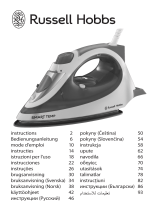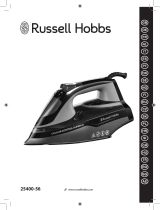
Introduction
Congratulations on your purchase and welcome to
Philips! To fully benet from the support that Philips offers,
register your product at www.philips.com/welcome.
Thanks to its compact, lightweight design, this iron is ideal
for quick ironing jobs. You can take it along in its handy
pouch when you are travelling.
The iron can safely be used at all mains voltages
(110-120V/220-240V), as it is equipped with a voltage
selector. If needed, suitable adapter plugs are available
from Philips dealers, service centres, hotel receptions or
hardware shops.
General description (Fig. 1)
A Steam boost button
B Steam control
C Temperature-ready light
D Cap of lling opening
E Filling opening
F Dual voltage selector
G Temperature control
H Mains cord
I Grip area
J Soleplate & button groove
Not shown: Pouch (specic types only)
Important
Read this user manual carefully before you use the
appliance and save it for future reference.
Danger
- Never immerse the iron in water.
Warning
- Check if the dual voltage selector has been set to
the local mains voltage before you connect the
appliance.You can adjust the position of the dual
voltage selector with a coin. Always reset the selector
to position 220/240V after use. This prevents damage
if you inadvertently connect the iron to the wrong
voltage.
- Do not use the appliance if the plug, the mains cord
or the appliance itself shows visible damage, or if the
appliance has been dropped or leaks.
- If the mains cord is damaged, you must have it
replaced by Philips, a service centre authorised by
Philips or similarly qualied persons in order to avoid
a hazard.
- Never leave the appliance unattended when it is
connected to the mains.
- This appliance is not intended for use by persons
(including children) with reduced physical, sensory
or mental capabilities, or lack of experience and
knowledge, unless they have been given supervision
or instruction concerning use of the appliance by a
person responsible for their safety.
- Children should be supervised to ensure that they
do not play with the appliance.
- Do not let the mains cord come into contact with
the hot soleplate of the iron.
Caution
- Only connect the appliance to an earthed wall
socket.
- Use an earthed adapter plug if the mains plug does
not match the local wall socket.
- Do not connect the appliance to a wall socket
intended for shavers.
- Do not use the iron in your hotel room
simultaneously with another high-wattage appliance
(e.g. a hairdryer) to avoid blowing the fuse.
- Check the mains cord regularly for possible damage.
- Always place and use the iron on a stable, level and
horizontal surface.
- The soleplate of the iron can become extremely hot
and may cause burns if touched.
- When you have nished ironing, when you clean the
appliance, when you ll or empty the water tank and
also when you leave the iron even for a short while:
set the steam control to position O, put the iron on
its heel and remove the mains plug from the wall
socket.
- The appliance is not intended for regular use.
Electromagnetic elds (EMF)
This Philips appliance complies with all standards
regarding electromagnetic elds (EMF). If handled
properly and according to the instructions in this user
manual, the appliance is safe to use based on scientic
evidence available today.
Before first use
1 Remove any sticker or protective foil from the
soleplate.
2 Let the iron heat up to maximum temperature and
pass the iron over a piece of damp cloth for several
minutes to remove any residues from the soleplate.
Preparing for use
Filling the water tank
1 Make sure the appliance is unplugged and the steam
control is set to position O (no steam).
2 Openthecapofthellingopening(Fig.2).
3 Fillthewatertankwithtapwateruptothe
maximumlevel.(Fig.3)
If the tap water is very hard, we advise you to use distilled
water.
DonotllthewatertankbeyondtheMAXindication.
Do not put perfume, vinegar, starch, descaling agents,
ironingaidsorotherchemicalsinthewatertank.
4 Closethecapofthellingopening(‘click’)(Fig.4).
Setting the temperature
1 Checkthelaundrycarelabelfortherequired
ironing temperature.
- 1 Synthetic fabrics (e.g. acrylic, nylon, polyamide,
polyester)
- 1 Silk
- 2 Wool
- 3 Cotton, linen
2 Setthetemperaturecontroltotherequiredironing
temperature(Fig.5).
3 Placetheirononitsheel(Fig.6).
4 Putthemainspluginanearthedwallsocket.
, The temperature-ready light goes on to indicate
thattheironisheatingup(Fig.7).
5 When the temperature-ready light has gone out,
waitawhilebeforeyoustartironing.
Tips
- If the article consists of various kinds of bres, always
select the temperature required by the most delicate
bre, i.e. the lowest temperature. If, for example, the
fabric consists of 60% polyester and 40% cotton, it
has to be ironed at the temperature indicated for
polyester ( 1).
- If you do not know what kind or kinds of fabric
an article is made of, determine the right ironing
temperature by ironing a part that is not visible when
you wear or use the article.
- Silk, woollen and synthetic materials: iron the reverse
side of the fabric to prevent shiny patches.
- Fabrics that tend to acquire shiny patches should be
ironed in one direction only (along with the nap)
while applying very little pressure.
- Start ironing the articles that require the lowest
ironing temperature, i.e. those made of synthetic
materials.
Using the appliance
Note: The iron may give off some smoke when you use it for
the rst time. This stops after a short while.
Steam ironing
1 Makesurethatthereisenoughwaterinthewater
tank(seechapter‘Preparingforuse’,section‘Filling
thewatertank’).
2 Settherequiredironingtemperature(see
chapter‘Preparingforuse’,section‘Settingthe
temperature’)(Fig.5).
Steam ironing is only possible at temperature setting
3.
3 Set the steam control to position \.(Fig.8)
, The iron starts to produce steam as soon as
it reaches the set temperature.
Ironing without steam
1 Settherequiredironingtemperature(see
chapter‘Preparingforuse’,section‘Settingthe
temperature’)(Fig.5).
2 Set the steam control to position O (no
steam)(Fig.9).
Steam boost
The steam boost provides extra steam to remove very
stubborn creases.
1 Makesurethatthereisenoughwaterinthewater
tank.
2 Settherequiredironingtemperature(see
chapter‘Preparingforuse’,section‘Settingthe
temperature’)(Fig.5).
The steam boost function can only be used at
temperature setting 3.
3 Pressandreleasethesteamboostbutton(Fig.10).
Ironing without ironing board
- When you are travelling, an ironing board is often
not at hand. In this case, use a cotton towel on a rm
at surface. (Fig. 11)
Make sure that the surface is heat-resistant and moisture-
resistant. Do not use a glass or plastic surface.
Cleaning
1 Place the iron on its heel.
2 Removethemainsplugfromthewallsocketandlet
theironcooldownforatleast30minutes.
3 Cleantheappliancewithadampcloth.
Tokeepthesoleplatesmooth,avoidhardcontactwith
metalobjects.Neveruseascouringpad,vinegaror
other chemicals to clean the soleplate.
Storage
1 Set the steam control to position O (no steam).
2 Place the iron on its heel.
3 Removethemainsplugfromthewallsocketandlet
theironcooldownforatleast30minutes.
4 Emptythewatertank(Fig.12).
Note: The water may be hot.
5 Windthemainscordroundtheappliance(Fig.13).
6 Storetheapplianceinthepouch(specictypes
only).
Environment
- Do not throw away the appliance with the normal
household waste at the end of its life, but hand it in
at an ofcial collection point for recycling. By doing
this, you help to preserve the environment (Fig. 14).
Guarantee & service
If you need service or information or if you have a
problem, please visit the Philips website at www.philips.
com or contact the Philips Consumer Care Centre
in your country (you nd its phone number in the
worldwide guarantee leaet). If there is no Consumer
Care Centre in your country, go to your local Philips
dealer.
Troubleshooting
This chapter summarises the most common problems
you could encounter with the appliance. If you are unable
to solve the problem with the information below, contact
the Consumer Care Centre in your country.
Problem Possiblecause Solution
The iron
is plugged
in, but the
soleplate
is cold.
There is a
connection
problem.
Check the mains
cord, the plug and
the wall socket.
The temperature
control is set to
MIN.
Set the temperature
control to the
required position
(see chapter
‘Preparing for use’,
section ‘Setting the
temperature’).
The iron
does not
produce
any
steam.
There is not
enough water in
the water tank.
Fill the water
tank (see chapter
‘Preparing for use’,
section ‘Filling the
water tank’).
The steam control
is set to position O.
Set the steam
control to
position U (see
chapter ‘Using the
appliance’, section
‘Steam ironing’).
ENGLISH








